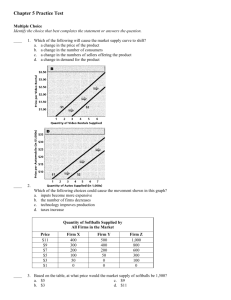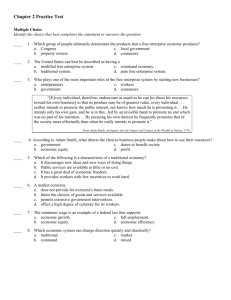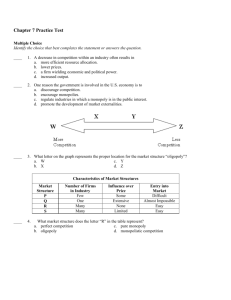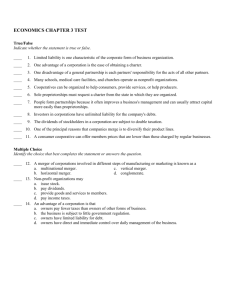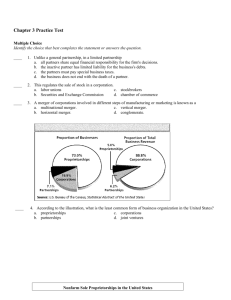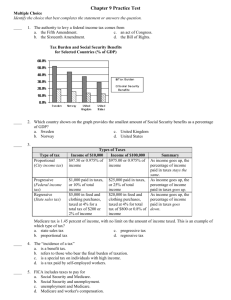Chapter 2 Test
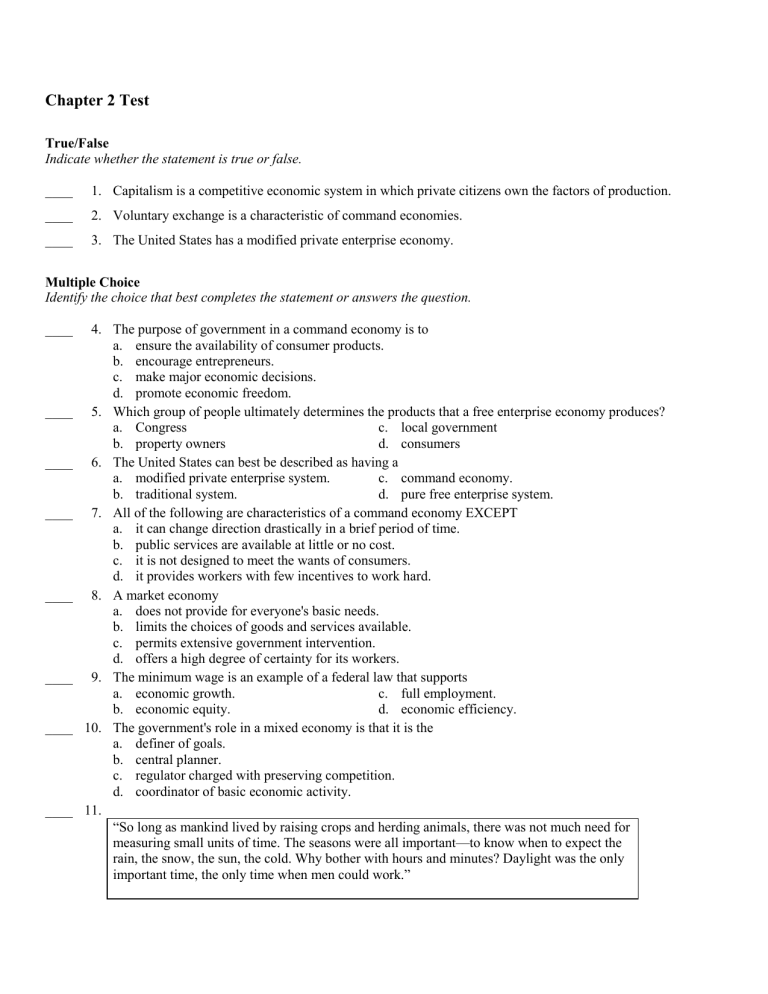
Chapter 2 Test
True/False
Indicate whether the statement is true or false.
____ 1. Capitalism is a competitive economic system in which private citizens own the factors of production.
____ 2. Voluntary exchange is a characteristic of command economies.
____ 3. The United States has a modified private enterprise economy.
Multiple Choice
Identify the choice that best completes the statement or answers the question.
____ 4. The purpose of government in a command economy is to a. ensure the availability of consumer products. b. encourage entrepreneurs. c. make major economic decisions. d. promote economic freedom.
____ 5. Which group of people ultimately determines the products that a free enterprise economy produces? a. Congress b. property owners c. local government d. consumers
____ 6. The United States can best be described as having a a. modified private enterprise system. c. command economy. b. traditional system. d. pure free enterprise system.
____ 7. All of the following are characteristics of a command economy EXCEPT a. it can change direction drastically in a brief period of time. b. public services are available at little or no cost. c. it is not designed to meet the wants of consumers. d. it provides workers with few incentives to work hard.
____ 8. A market economy a. does not provide for everyone's basic needs. b. limits the choices of goods and services available. c. permits extensive government intervention. d. offers a high degree of certainty for its workers.
____ 9. The minimum wage is an example of a federal law that supports a. economic growth. c. full employment. b. economic equity. d. economic efficiency.
____ 10. The government's role in a mixed economy is that it is the a. definer of goals. b. central planner. c. regulator charged with preserving competition. d. coordinator of basic economic activity.
____ 11.
“So long as mankind lived by raising crops and herding animals, there was not much need for measuring small units of time. The seasons were all important—to know when to expect the rain, the snow, the sun, the cold. Why bother with hours and minutes? Daylight was the only important time, the only time when men could work.”
From Daniel J. Boorstin’s The Discoverers: A History of Man’s Search to Know His World and Himself,
1985
What type of economic system does this passage describe? a. traditional economy c. market economy b. command economy d. mixed economy
____ 12.
Diaguita Indians have lived in this region for generations...We grow beans, corn and potatoes on the mountain slopes. To irrigate these crops, we still use the channels built centuries ago by our ancestors. We also breed llamas...In our community, the more llamas you own, the richer you are.
In the economic system described in this passage, answers to the basic economic questions would be determined by a. habit and custom. b. government leaders. c. market prices. d. individual consumers.
Completion
Complete each statement.
13. The way in which a society provides for the wants and needs of its people determines the type of
____________________ it has.
14. One disadvantage of a ____________________ economy is the high degree of uncertainty that businesses and workers face as the result of change.
15. A rise in the general level of prices is called ____________________.
16. Economic ____________________ is an economic goal that is based on a sense of fairness.
17. Economic ____________________ is necessary to meet the needs of a growing population by providing more goods and services.
18. Social Security is a federal program that addresses the goal of economic ____________________.
19. Political elections are one method of resolving conflicts among economic ____________________.
20. In a free enterprise system, people who risk their savings to gain wealth are doing it because of the
____________________.
21. Capitalism benefits consumers because ____________________ keeps prices low.
22. In a _________________________, a central authority makes most of the WHAT, HOW, and FOR WHOM decisions.
23. Our economic system is called a ________________________________________ because people generally carry on their economic affairs freely, but are subject to some government regulation.
Matching
Match each statement with the correct item below.
a. role of the consumer as ruler of the market b. society's way of providing for wants and needs c. program that provides retirement and disability benefits for working people d. economic system in which the allocation of resources and nearly all other economic activity stems from ritual or habit e. struggle among sellers to attract consumers f. economy in which people carry on their economic affairs freely but are subject to some government intervention and regulation g. economic system in which people and firms act in their own best interests to answer economic questions h. economy in which competition is allowed to flourish with a minimum of government interference i. degree to which people are better off after completing an economic activity j. rise in the general level of prices
____ 24. modified private enterprise economy
____ 25. competition
____ 26. economy
____ 27. consumer sovereignty
____ 28. profit
____ 29. traditional economy
____ 30. inflation
____ 31. Social Security
____ 32. free enterprise
____ 33. market economy
Short Answer
34. Synthesizing Information government spending.
Discuss inflation as it affects one of the following: labor, consumers, or
35. Making Generalizations Why is the entrepreneur so important in the free enterprise economy?
APPLYING SKILLS
Using Graphs: Study the graph and answer the questions below.
36.
During which two-year period did inflation increase the most?
37.
During which year was inflation at the highest?
38.
What was the approximate percentage change in inflation from 1990 to 1992? Did it increase or decrease?
39.
During which two-year period did inflation decrease the most?
40.
During which year was inflation at the lowest?
41.
What was the approximate percentage change in inflation from 1982 to 1984? Did it increase or decrease?
42.
Advantages Disadvantages
Capable of dramatic change in a short time Does not meet wants and needs of consumers
Little uncertainty over choice of career, where to work, or losing job
Lacks effective incentives to get people to work
Many basic education, public health, and other public services available at little or no cost
New and different ideas discouraged, no room for individuality
What economic system does the information in this table describe?
Essay
43.
When Ronald Reagan ran for president in 1980 he rejected the prevailing economic theory.
He believed in free markets and opposed the idea that the federal government should influence the ups and downs of business with its policies. He particularly rejected the idea of government spending more than it takes in and the national debt that results.
Source: Adapted from " Reaganomics Shape 1980s Economy ." 1997.
Based on this passage, do you think Ronald Reagan would have favored a government-sponsored program to give jobs to unemployed people? Explain.
Chapter 2 Test
Answer Section
TRUE/FALSE
1. ANS: T PTS: 1 DIF: Easy
REF: Learn more about this question in Economics Principles and Practices, page 46, and in the Reading
Essentials and Study Guide, Chapter 2, Section 3. For additional practice, complete Chapter 2, Section 3, of the Interactive Tutor Self-Assessment CD-ROM, and visit this book's Online Learning Center at epp.glencoe.com. NOT: Page 46
2. ANS: F PTS: 1 DIF: Average
REF: Learn more about this question in Economics Principles and Practices, page 47, and in the Reading
Essentials and Study Guide, Chapter 2, Section 3. For additional practice, complete Chapter 2, Section 3, of the Interactive Tutor Self-Assessment CD-ROM, and visit this book's Online Learning Center at epp.glencoe.com. NOT: Page 47
3. ANS: T PTS: 1 DIF: Average
REF: Learn more about this question in Economics Principles and Practices, page 51, and in the Reading
Essentials and Study Guide, Chapter 2, Section 3. For additional practice, complete Chapter 2, Section 3, of the Interactive Tutor Self-Assessment CD-ROM, and visit this book's Online Learning Center at epp.glencoe.com. NOT: Page 51
MULTIPLE CHOICE
4. ANS: C PTS: 1 DIF: Average
REF: Learn more about this question in Economics Principles and Practices, page 35, and in the Reading
Essentials and Study Guide, Chapter 2, Section 1. For additional practice, complete Chapter 2, Section 1, of the Interactive Tutor Self-Assessment CD-ROM, and visit this book's Online Learning Center at epp.glencoe.com. NOT: Page 35
5. ANS: D PTS: 1 DIF: Easy
REF: Learn more about this question in Economics Principles and Practices, page 46, and in the Reading
Essentials and Study Guide, Chapter 2, Section 3. For additional practice, complete Chapter 2, Section 3, of the Interactive Tutor Self-Assessment CD-ROM, and visit this book's Online Learning Center at epp.glencoe.com. NOT: Page 46
6. ANS: A PTS: 1 DIF: Easy
REF: Learn more about this question in Economics Principles and Practices, page 51, and in the Reading
Essentials and Study Guide, Chapter 2, Section 3. For additional practice, complete Chapter 2, Section 3, of the Interactive Tutor Self-Assessment CD-ROM, and visit this book's Online Learning Center at epp.glencoe.com. NOT: Page 51
7. ANS: B PTS: 1 DIF: Challenging
REF: Learn more about this question in Economics Principles and Practices, pages 35-36, and in the
Reading Essentials and Study Guide, Chapter 2, Section 1. For additional practice, complete Chapter 2,
Section 1, of the Interactive Tutor Self-Assessment CD-ROM, and visit this book's Online Learning Center at epp.glencoe.com. NOT: Pages 35-36
8. ANS: A PTS: 1 DIF: Average
REF: Learn more about this question in Economics Principles and Practices, pages 36-39, and in the
Reading Essentials and Study Guide, Chapter 2, Section 1. For additional practice, complete Chapter 2,
Section 1, of the Interactive Tutor Self-Assessment CD-ROM, and visit this book's Online Learning Center at epp.glencoe.com. NOT: Pages 36-39
9. ANS: B PTS: 1 DIF: Average
REF: Learn more about this question in Economics Principles and Practices, page 42, and in the Reading
Essentials and Study Guide, Chapter 2, Section 2. For additional practice, complete Chapter 2, Section 2, of the Interactive Tutor Self-Assessment CD-ROM, and visit this book's Online Learning Center at epp.glencoe.com. NOT: Page 42
10. ANS: C PTS: 1 DIF: Average
REF: Learn more about this question in Economics Principles and Practices, page 51, and in the Reading
Essentials and Study Guide, Chapter 2, Section 3. For additional practice, complete Chapter 2, Section 3, of the Interactive Tutor Self-Assessment CD-ROM, and visit this book's Online Learning Center at epp.glencoe.com. NOT: Page 51
11. ANS: A PTS: 1 DIF: Easy
REF: Learn more about this question in Economics Principles and Practices, page 34, and in the Reading
Essentials and Study Guide, Chapter 2, Section 1. For additional practice, complete Chapter 2, Section 1, of the Interactive Tutor Self-Assessment CD-ROM, and visit this book's Online Learning Center at epp.glencoe.com. MSC: Document Based Question NOT: Page 34
12. ANS: A PTS: 1 DIF: Average
REF: Learn more about this question in Economics Principles and Practices, page 34, and in the Reading
Essentials and Study Guide, Chapter 2, Section 1. For additional practice, complete Chapter 2, Section 1, of the Interactive Tutor Self-Assessment CD-ROM, and visit this book's Online Learning Center at epp.glencoe.com. MSC: Document Based Question NOT: Page 34
COMPLETION
13. ANS: economic system
PTS: 1 DIF: Easy
REF: Learn more about this question in Economics Principles and Practices, page 33, and in the Reading
Essentials and Study Guide, Chapter 2, Section 1. For additional practice, complete Chapter 2, Section 1, of the Interactive Tutor Self-Assessment CD-ROM, and visit this book's Online Learning Center at epp.glencoe.com. NOT: Page 33
14. ANS: market
PTS: 1 DIF: Average
REF: Learn more about this question in Economics Principles and Practices, page 39, and in the Reading
Essentials and Study Guide, Chapter 2, Section 1. For additional practice, complete Chapter 2, Section 1, of the Interactive Tutor Self-Assessment CD-ROM, and visit this book's Online Learning Center at epp.glencoe.com. NOT: Page 39
15. ANS: inflation
PTS: 1 DIF: Easy
REF: Learn more about this question in Economics Principles and Practices, page 43, and in the Reading
Essentials and Study Guide, Chapter 2, Section 2. For additional practice, complete Chapter 2, Section 2, of the Interactive Tutor Self-Assessment CD-ROM, and visit this book's Online Learning Center at epp.glencoe.com. NOT: Page 43
16. ANS: equity
PTS: 1 DIF: Average
REF: Learn more about this question in Economics Principles and Practices, page 42, and in the Reading
Essentials and Study Guide, Chapter 2, Section 2. For additional practice, complete Chapter 2, Section 2, of the Interactive Tutor Self-Assessment CD-ROM, and visit this book's Online Learning Center at
epp.glencoe.com. NOT: Page 42
17. ANS: growth
PTS: 1 DIF: Challenging
REF: Learn more about this question in Economics Principles and Practices, page 43, and in the Reading
Essentials and Study Guide, Chapter 2, Section 2. For additional practice, complete Chapter 2, Section 2, of the Interactive Tutor Self-Assessment CD-ROM, and visit this book's Online Learning Center at epp.glencoe.com. NOT: Page 43
18. ANS: security
PTS: 1 DIF: Average
REF: Learn more about this question in Economics Principles and Practices, page 42, and in the Reading
Essentials and Study Guide, Chapter 2, Section 2. For additional practice, complete Chapter 2, Section 2, of the Interactive Tutor Self-Assessment CD-ROM, and visit this book's Online Learning Center at epp.glencoe.com. NOT: Page 42
19. ANS: goals
PTS: 1 DIF: Average
REF: Learn more about this question in Economics Principles and Practices, page 44, and in the Reading
Essentials and Study Guide, Chapter 2, Section 2. For additional practice, complete Chapter 2, Section 2, of the Interactive Tutor Self-Assessment CD-ROM, and visit this book's Online Learning Center at epp.glencoe.com. NOT: Page 44
20. ANS: profit motive
PTS: 1 DIF: Average
REF: Learn more about this question in Economics Principles and Practices, page 48, and in the Reading
Essentials and Study Guide, Chapter 2, Section 3. For additional practice, complete Chapter 2, Section 3, of the Interactive Tutor Self-Assessment CD-ROM, and visit this book's Online Learning Center at epp.glencoe.com. NOT: Page 48
21. ANS: competition
PTS: 1 DIF: Average
REF: Learn more about this question in Economics Principles and Practices, page 48, and in the Reading
Essentials and Study Guide, Chapter 2, Section 3. For additional practice, complete Chapter 2, Section 3, of the Interactive Tutor Self-Assessment CD-ROM, and visit this book's Online Learning Center at epp.glencoe.com. NOT: Page 48
22. ANS: command economy
PTS: 1 DIF: Easy
REF: Learn more about this question in Economics Principles and Practices, page 35, and in the Reading
Essentials and Study Guide, Chapter 2, Section 1. For additional practice, complete Chapter 2, Section 1, of the Interactive Tutor Self-Assessment CD-ROM, and visit this book's Online Learning Center at epp.glencoe.com. NOT: Page 35
23. ANS: modified private enterprise economy
PTS: 1 DIF: Average
REF: Learn more about this question in Economics Principles and Practices, page 51, and in the Reading
Essentials and Study Guide, Chapter 2, Section 3. For additional practice, complete Chapter 2, Section 3, of the Interactive Tutor Self-Assessment CD-ROM, and visit this book's Online Learning Center at epp.glencoe.com. NOT: Page 51
MATCHING
24. ANS: F PTS: 1 DIF: Average
REF: Learn more about this question in Economics Principles and Practices, page 51, and in the Reading
Essentials and Study Guide, Chapter 2, Section 3. For additional practice, complete Chapter 2, Section 3, of the Interactive Tutor Self-Assessment CD-ROM, and visit this book's Online Learning Center at epp.glencoe.com. NOT: Page 51
25. ANS: E PTS: 1 DIF: Easy
REF: Learn more about this question in Economics Principles and Practices, page 48, and in the Reading
Essentials and Study Guide, Chapter 2, Section 3. For additional practice, complete Chapter 2, Section 3, of the Interactive Tutor Self-Assessment CD-ROM, and visit this book's Online Learning Center at epp.glencoe.com. NOT: Page 48
26. ANS: B PTS: 1 DIF: Average
REF: Learn more about this question in Economics Principles and Practices, page 33, and in the Reading
Essentials and Study Guide, Chapter 2, Section 1. For additional practice, complete Chapter 2, Section 1, of the Interactive Tutor Self-Assessment CD-ROM, and visit this book's Online Learning Center at epp.glencoe.com. NOT: Page 33
27. ANS: A PTS: 1 DIF: Average
REF: Learn more about this question in Economics Principles and Practices, page 50, and in the Reading
Essentials and Study Guide, Chapter 2, Section 3. For additional practice, complete Chapter 2, Section 3, of the Interactive Tutor Self-Assessment CD-ROM, and visit this book's Online Learning Center at epp.glencoe.com. NOT: Page 50
28. ANS: I PTS: 1 DIF: Easy
REF: Learn more about this question in Economics Principles and Practices, page 48, and in the Reading
Essentials and Study Guide, Chapter 2, Section 3. For additional practice, complete Chapter 2, Section 3, of the Interactive Tutor Self-Assessment CD-ROM, and visit this book's Online Learning Center at epp.glencoe.com. NOT: Page 48
29. ANS: D PTS: 1 DIF: Average
REF: Learn more about this question in Economics Principles and Practices, page 34, and in the Reading
Essentials and Study Guide, Chapter 2, Section 1. For additional practice, complete Chapter 2, Section 1, of the Interactive Tutor Self-Assessment CD-ROM, and visit this book's Online Learning Center at epp.glencoe.com. NOT: Page 34
30. ANS: J PTS: 1 DIF: Average
REF: Learn more about this question in Economics Principles and Practices, page 43, and in the Reading
Essentials and Study Guide, Chapter 2, Section 2. For additional practice, complete Chapter 2, Section 2, of the Interactive Tutor Self-Assessment CD-ROM, and visit this book's Online Learning Center at epp.glencoe.com. NOT: Page 43
31. ANS: C PTS: 1 DIF: Easy
REF: Learn more about this question in Economics Principles and Practices, page 42, and in the Reading
Essentials and Study Guide, Chapter 2, Section 2. For additional practice, complete Chapter 2, Section 2, of the Interactive Tutor Self-Assessment CD-ROM, and visit this book's Online Learning Center at epp.glencoe.com. NOT: Page 42
32. ANS: H PTS: 1 DIF: Average
REF: Learn more about this question in Economics Principles and Practices, page 46, and in the Reading
Essentials and Study Guide, Chapter 2, Section 3. For additional practice, complete Chapter 2, Section 3, of the Interactive Tutor Self-Assessment CD-ROM, and visit this book's Online Learning Center at epp.glencoe.com. NOT: Page 46
33. ANS: G PTS: 1 DIF: Average
REF: Learn more about this question in Economics Principles and Practices, page 36, and in the Reading
Essentials and Study Guide, Chapter 2, Section 1. For additional practice, complete Chapter 2, Section 1, of the Interactive Tutor Self-Assessment CD-ROM, and visit this book's Online Learning Center at epp.glencoe.com. NOT: Page 36
SHORT ANSWER
34. ANS:
Answers may include the following: inflation may affect labor by causing a business to reduce its workforce and by reducing the effective spending power of workers' salaries. It may affect consumers by limiting their consumption habits. It may result in cuts in government spending.
PTS: 1 DIF: Challenging
REF: Learn more about this question in Economics Principles and Practices, page 43, and in the Reading
Essentials and Study Guide, Chapter 2, Section 2. For additional practice, complete Chapter 2, Section 2, of the Interactive Tutor Self-Assessment CD-ROM, and visit this book's Online Learning Center at epp.glencoe.com. NOT: Page 43
35. ANS:
Entrepreneurs introduce new ideas about products, manufacturing, and services. They provide consumers with the products they want, at prices they want to pay. They create competition with existing businesses that helps to reduce costs and improve the quality of goods. They provide jobs for workers.
PTS: 1 DIF: Challenging
REF: Learn more about this question in Economics Principles and Practices, pages 48-49, and in the
Reading Essentials and Study Guide, Chapter 2, Section 3. For additional practice, complete Chapter 2,
Section 3, of the Interactive Tutor Self-Assessment CD-ROM, and visit this book's Online Learning Center at epp.glencoe.com. NOT: Pages 48-49
36. ANS:
1986-1988
PTS: 1 DIF: Average
REF: Learn more about this question in Economics Principles and Practices, page 43, and in the Reading
Essentials and Study Guide, Chapter 2, Section 2. For additional practice, complete Chapter 2, Section 2, of the Interactive Tutor Self-Assessment CD-ROM, and visit this book's Online Learning Center at epp.glencoe.com. MSC: Document Based Question NOT: Page 43
37. ANS:
1980
PTS: 1 DIF: Average
REF: Learn more about this question in Economics Principles and Practices, page 43, and in the Reading
Essentials and Study Guide, Chapter 2, Section 2. For additional practice, complete Chapter 2, Section 2, of the Interactive Tutor Self-Assessment CD-ROM, and visit this book's Online Learning Center at epp.glencoe.com. MSC: Document Based Question NOT: Page 43
38. ANS:
2.4 percent decrease
PTS: 1 DIF: Challenging
REF: Learn more about this question in Economics Principles and Practices, page 43, and in the Reading
Essentials and Study Guide, Chapter 2, Section 2. For additional practice, complete Chapter 2, Section 2, of the Interactive Tutor Self-Assessment CD-ROM, and visit this book's Online Learning Center at
epp.glencoe.com. MSC: Document Based Question NOT: Page 43
39. ANS:
1980-1982
PTS: 1 DIF: Average
REF: Learn more about this question in Economics Principles and Practices, page 43, and in the Reading
Essentials and Study Guide, Chapter 2, Section 2. For additional practice, complete Chapter 2, Section 2, of the Interactive Tutor Self-Assessment CD-ROM, and visit this book's Online Learning Center at epp.glencoe.com. MSC: Document Based Question NOT: Page 43
40. ANS:
1998
PTS: 1 DIF: Average
REF: Learn more about this question in Economics Principles and Practices, page 43, and in the Reading
Essentials and Study Guide, Chapter 2, Section 2. For additional practice, complete Chapter 2, Section 2, of the Interactive Tutor Self-Assessment CD-ROM, and visit this book's Online Learning Center at epp.glencoe.com. MSC: Document Based Question NOT: Page 43
41. ANS:
1.9 percent decrease
PTS: 1 DIF: Challenging
REF: Learn more about this question in Economics Principles and Practices, page 43, and in the Reading
Essentials and Study Guide, Chapter 2, Section 2. For additional practice, complete Chapter 2, Section 2, of the Interactive Tutor Self-Assessment CD-ROM, and visit this book's Online Learning Center at epp.glencoe.com. MSC: Document Based Question NOT: Page 43
42. ANS: command economy command system
PTS: 1 DIF: Easy
REF: Learn more about this question in Economics Principles and Practices, pages 35-36, and in the
Reading Essentials and Study Guide, Chapter 2, Section 1. For additional practice, complete Chapter 2,
Section 1, of the Interactive Tutor Self-Assessment CD-ROM, and visit this book's Online Learning Center at epp.glencoe.com. MSC: Document Based Question NOT: Pages 35-36
ESSAY
43. ANS:
Reagan probably would not have favored a government-sponsored jobs program. Unemployment is part of the “ups and downs” of business that Reagan did not want government to influence. Also, Reagan wanted less government spending. A jobs program would require a large amount of government spending and could increase the national debt.
PTS: 1 DIF: Challenging
REF: Learn more about this question in Economics Principles and Practices, pages 36-38, and in the
Reading Essentials and Study Guide, Chapter 2, Section 1. For additional practice, complete Chapter 2,
Section 1, of the Interactive Tutor Self-Assessment CD-ROM, and visit this book's Online Learning Center at epp.glencoe.com. MSC: Document Based Question NOT: Pages 36-38

